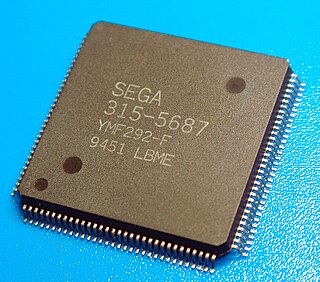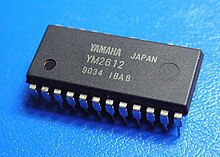
A sound card is an internal expansion card that provides input and output of audio signals to and from a computer under the control of computer programs. The term sound card is also applied to external audio interfaces used for professional audio applications.

Sound Blaster is a family of sound cards and audio peripherals designed by Singaporean technology company Creative Technology. The first Sound Blaster card was introduced in 1989.

The SN76489 Digital Complex Sound Generator (DCSG) is a TTL-compatible programmable sound generator chip from Texas Instruments. Its main application was the generation of music and sound effects in game consoles, arcade video games, and home computers, competing with the similar General Instrument AY-3-8910.

The Yamaha DX7 is a synthesizer manufactured by the Yamaha Corporation from 1983 to 1989. It was the first successful digital synthesizer and is one of the best-selling synthesizers in history, selling more than 200,000 units.
The digital sound revolution refers to the widespread adoption of digital audio technology in the computer industry beginning in the 1980s.

The Covox Speech Thing is an external digital-to-analog converter (DAC) that plugs into the parallel printer port of a PC. It converts 8-bit digital sound using a simple R-2R resistor ladder into an analog signal output.

The YM2413, a.k.a. OPLL, is a cost-reduced FM synthesis sound chip manufactured by Yamaha Corporation and based on their YM3812 (OPL2).

The AY-3-8910 is a 3-voice programmable sound generator (PSG) designed by General Instrument (GI) in 1978, initially for use with their 16-bit CP1610 or one of the PIC1650 series of 8-bit microcomputers. The AY-3-8910 and its variants were used in many arcade games—Konami's Gyruss contains five—and Bally pinball machines as well as being the sound chip in the Intellivision and Vectrex video game consoles, and the Amstrad CPC, Oric-1, Colour Genie, Elektor TV Games Computer, MSX, Tiki 100 and later ZX Spectrum home computers. It was also used in the Mockingboard and Cricket sound cards for the Apple II and the Speech/Sound Cartridge for the TRS-80 Color Computer.

Sound Blaster Live! is a PCI add-on sound card from Creative Technology Limited for PCs. Moving from ISA to PCI allowed the card to dispense with onboard memory, storing digital samples in the computer's main memory and then accessing them in real time over the bus. This allowed for a much wider selection of, and longer playing, samples. It also included higher quality sound output at all levels, quadrophonic output, and a new MIDI synthesizer with 64 sampled voices. The Live! was introduced on August 11, 1998 and variations on the design remained Creative's primary sound card line into the early 2000's.

The Yamaha YM2151, also known as OPM is an eight-channel, four-operator sound chip. It was Yamaha's first single-chip FM synthesis implementation, being created originally for some of the Yamaha DX series of keyboards. Yamaha also used it in some of their budget-priced electric pianos, such as the YPR-7, -8, and -9.

The music of the Streets of Rage series of beat 'em up games, released in the early 1990s, was primarily produced by Yuzo Koshiro.
A programmable sound generator (PSG) is a sound chip that generates audio wave signals built from one or more basic waveforms, and often some kind of noise. PSGs use a relatively simple method of creating sound compared to other methods such as frequency modulation synthesis or pulse-code modulation.

The YM2203, a.k.a. OPN, is a six-channel sound chip developed by Yamaha. It was the progenitor of Yamaha's OPN family of FM synthesis chips used in many video game and computer systems throughout the 1980s and early 1990s. It was used in a variety of NEC computers, along with various arcade game machines.

The YM2608, a.k.a. OPNA, is a sound chip developed by Yamaha. It is a member of Yamaha's OPN family of FM synthesis chips, and is the successor to the YM2203. It was notably used in NEC's PC-8801/PC-9801 series computers.

The YM2610, a.k.a. OPNB, is a sound chip developed by Yamaha. It is a member of Yamaha's OPN family of FM synthesis chips, and related to the YM2608.

The YMF292, aka SCSP is a multi-function sound chip developed by Yamaha for the Sega Saturn, and was also used in Sega's arcade version of the Saturn, the ST-V, along with the Model 2 and Model 3.
The Yamaha YMZ280B, also known as PCMD8, is a sound chip produced by Yamaha Corporation. It is an eight-channel PCM/ADPCM sample-based synthesizer designed for use with video game machines, packaged in a 64-pin QFP.
The OPL series are a family of sound chips developed by Yamaha. The OPL series are low-cost sound chips providing FM synthesis for use in computing, music and video game applications.













